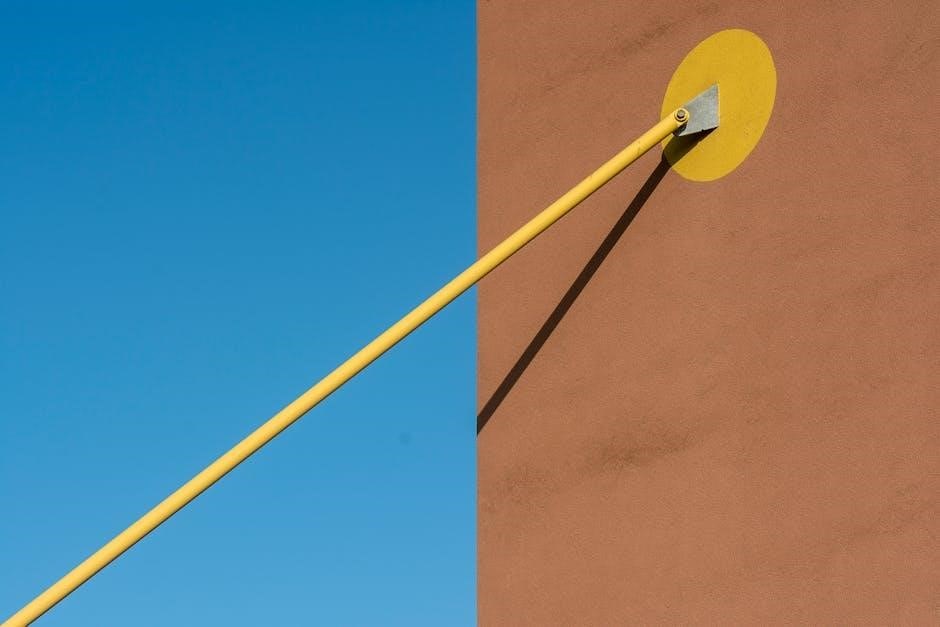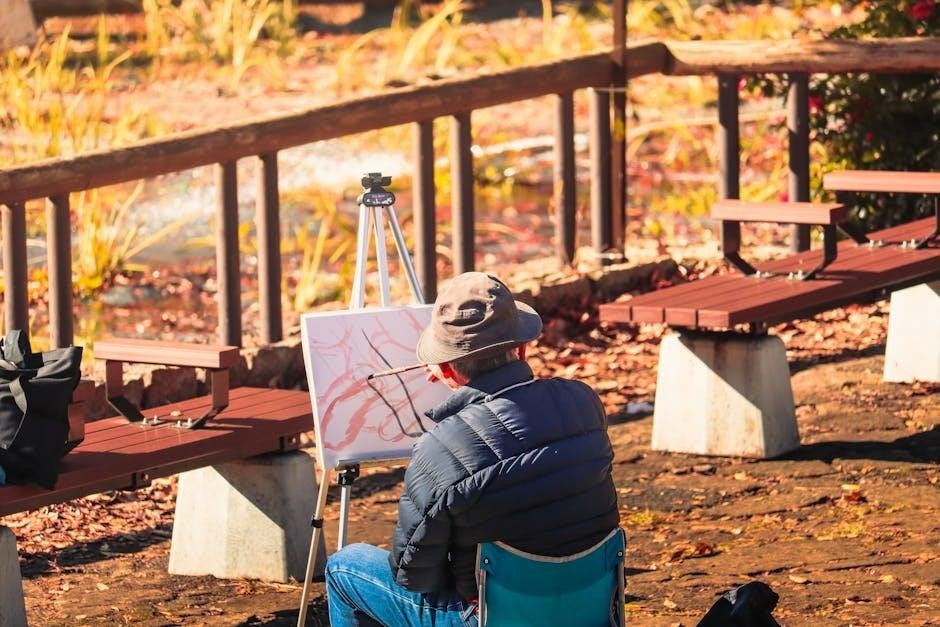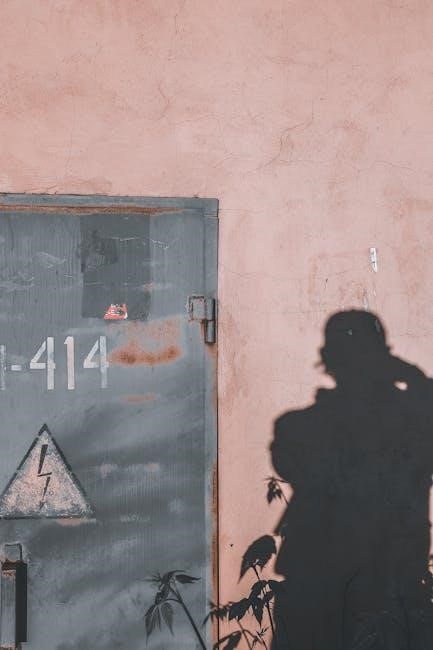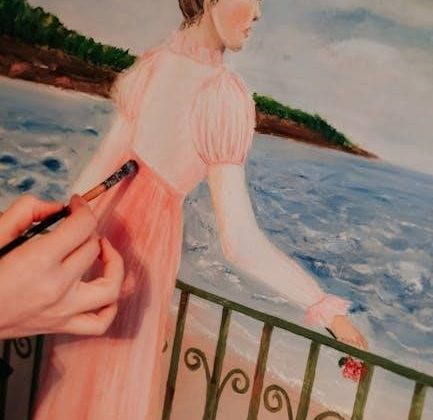Edgar Payne’s “Composition of Outdoor Painting” is a timeless guide for artists, offering insights into landscape and plein-air painting techniques, composition, and design.
Biography of Edgar Payne
Edgar Payne (1883-1947) was a renowned American landscape painter and author, best known for his expertise in plein-air painting and his seminal book on composition.
Early Life and Artistic Training
Edgar Alwin Payne was born in 1883 in Washburn, Wisconsin. From an early age, he demonstrated a keen interest in art, which led him to pursue formal training. Payne moved to Chicago to study at the Art Institute of Chicago, where he honed his skills in drawing and painting. His early work was influenced by the natural landscapes of the Midwest, sparking a lifelong passion for capturing outdoor scenes. Payne’s artistic foundation was further enriched by travels to Europe, where he was exposed to the works of master painters. These experiences shaped his approach to landscape painting and laid the groundwork for his later contributions to the field.
Payne’s Contributions to Landscape Painting
Edgar Payne is celebrated as a master of landscape painting, particularly in the realm of plein-air and outdoor compositions. His work captured the essence of natural beauty, emphasizing harmony and balance. Payne’s paintings often featured dramatic skies, rugged mountain vistas, and serene lakes, showcasing his ability to convey light and atmosphere. He was also known for his large-scale mural projects, including an 11,000-square-foot mural for the Congress Hotel in Chicago. Payne’s teachings, as outlined in “Composition of Outdoor Painting,” have inspired generations of artists, offering practical insights into design, color, and composition. His contributions remain a cornerstone of landscape painting education and practice.

Evolution of the Book “Composition of Outdoor Painting”
First published in 1941, the book has evolved through editions, with the 7th edition (2019) offering enhanced insights and color plates, becoming a detailed guide for artists.

Publication History and Editions
First published in 1941, Composition of Outdoor Painting has undergone several editions, each enhancing its content. The 5th edition, released later, included additional color plates and an addenda by Evelyn Payne Hatcher, making it a valuable resource for artists and collectors. The 7th edition, published in 2019 by DeRus Fine Arts, expanded to 170 pages, offering deeper insights into plein-air painting techniques and composition. This edition is particularly noted for its comprehensive approach, making it a must-have for both novice and experienced painters. The book’s evolution reflects its enduring relevance, with each edition building on the previous, ensuring it remains a timeless guide for landscape artists. Its detailed structure and practical advice have solidified its place as a cornerstone in art education and practice.
Key Features of the 7th Edition
The 7th edition of Composition of Outdoor Painting by Edgar Payne is a comprehensive resource, expanded to 170 pages. It includes additional color plates and detailed insights into plein-air painting techniques, making it a valuable tool for artists. This edition builds on the original 1941 publication, offering a deeper exploration of composition, color, and light. The book is structured to provide practical advice, making it accessible to both beginners and seasoned painters. Its concise yet thorough approach ensures that readers can apply the principles directly to their work. The inclusion of visual aids and enhanced content makes this edition a significant upgrade, solidifying its reputation as a essential guide for landscape painting enthusiasts.
Core Principles of Outdoor Painting Composition
Edgar Payne’s guide emphasizes line, shape, balance, harmony, color, and light, providing foundational techniques for creating dynamic and visually appealing outdoor compositions.
Understanding Line and Shape in Landscape Painting
Edgar Payne’s “Composition of Outdoor Painting” underscores the importance of line and shape as foundational elements in landscape art. Lines define form, rhythm, and movement, guiding the viewer’s eye through the painting. Shapes, whether geometric or organic, simplify complex subjects into manageable forms, enhancing composition and balance. Payne emphasizes how lines can suggest texture, distance, and energy, while shapes create visual unity. His practical approach helps artists break down natural forms into basic elements, ensuring dynamic and harmonious outdoor paintings. This section is invaluable for mastering the structure and organization of landscape compositions, providing a solid foundation for capturing light, movement, and space in plein-air settings. Payne’s insights remain essential for artists seeking to refine their skills in interpreting the natural world through art.
Balance and Harmony in Outdoor Compositions
Edgar Payne’s “Composition of Outdoor Painting” highlights balance and harmony as critical elements in creating visually appealing outdoor compositions. Balance is achieved through the thoughtful placement of forms, values, and colors, ensuring no single element overwhelms the viewer. Harmony is attained by unifying these components, creating a cohesive and natural representation of the landscape. Payne emphasizes the importance of symmetry and contrast, as well as the subtle use of negative space, to guide the viewer’s eye effectively. These principles help artists create paintings that are not only aesthetically pleasing but also evoke a sense of calm and connection to nature. Payne’s teachings provide practical strategies for achieving balance and harmony, making them indispensable for landscape painters seeking to refine their craft. His insights remain timeless, offering a foundation for creating compelling and emotionally resonant outdoor compositions.
Color and Light: Essential Elements of Outdoor Painting
Color and light are pivotal elements in outdoor painting, as emphasized in Edgar Payne’s “Composition of Outdoor Painting.” Payne underscores the importance of capturing the fleeting effects of natural light and its interplay with color to create dynamic and lifelike scenes. He advocates for careful observation of how light transforms colors in the landscape, from the warmth of direct sunlight to the cool tones of shadows. Payne’s approach encourages artists to use color harmony and contrast to evoke mood and depth, while his techniques for capturing light ensure a sense of realism and immediacy. By mastering these principles, painters can infuse their work with vitality and emotional resonance, making color and light indispensable tools in their creative process. Payne’s insights remain a cornerstone for achieving authenticity and beauty in outdoor compositions.
Practical Applications of Payne’s Teachings
Payne’s teachings provide artists with practical tools for plein-air painting, emphasizing composition, light, and color techniques to capture outdoor scenes effectively and authentically.
Techniques for Plein-Air Painting
Edgar Payne’s “Composition of Outdoor Painting” offers invaluable techniques for plein-air artists, emphasizing the importance of capturing light and color harmony in natural settings. Payne advocates for starting with quick sketches to study the play of light and shadow, ensuring compositions are dynamic and balanced. He stresses the use of a limited palette to achieve unity and vibrancy, while his methods for simplifying complex landscapes help artists focus on essential elements. Practical advice on handling outdoor challenges, such as changing light conditions, is also provided. These techniques, rooted in traditional practices, empower artists to create compelling and authentic outdoor paintings. Payne’s insights remain a cornerstone for plein-air enthusiasts, guiding them to master the fleeting effects of nature with confidence and precision.
Overcoming Common Challenges in Outdoor Painting
Edgar Payne’s “Composition of Outdoor Painting” addresses common challenges faced by plein-air artists, such as shifting light, unpredictable weather, and capturing dynamic natural scenes. Payne emphasizes the importance of quick decision-making and adaptability, encouraging artists to prioritize essential elements over detail. He advises using sketching as a tool to study light and composition before committing to a full painting. Payne also provides practical tips for simplifying complex subjects and managing time effectively in outdoor settings. His guidance on handling harsh weather conditions, such as strong winds or intense sunlight, equips artists with the skills to maintain focus and creativity. By mastering these strategies, artists can transform challenges into opportunities for growth and innovation in their work.

Influence of “Composition of Outdoor Painting” on Modern Art
Edgar Payne’s book remains a cornerstone in modern art education, inspiring contemporary artists and educators with its timeless principles of composition and plein-air techniques.
Contemporary Artists Inspired by Payne’s Work
Edgar Payne’s teachings continue to inspire modern artists, with many contemporary painters drawing from his principles of composition and light. Artists like Peter Han and Paul Seawright have credited Payne’s work as a foundational influence, incorporating his techniques into their own plein-air and landscape paintings. The book’s emphasis on practical application has made it a staple for artists seeking to refine their skills. Many modern painters appreciate how Payne’s insights bridge traditional methods with contemporary practices, ensuring his legacy endures. The availability of Composition of Outdoor Painting as a PDF has further expanded its reach, inspiring a new generation of artists to explore and master outdoor painting.
The Book’s Role in Art Education
Edgar Payne’s “Composition of Outdoor Painting” has become a cornerstone in art education, providing students and instructors with a comprehensive guide to landscape painting. Its clear, concise lessons on composition, light, and color make it an invaluable resource for both classroom and field study. Art schools and educators often recommend the book for its practical, timeless advice, which bridges theory and practice. The inclusion of illustrations and practical examples further enhances its educational value. Additionally, the availability of the book in PDF format has made it more accessible to modern students, ensuring Payne’s teachings reach a wider audience. This accessibility has solidified its role as a key educational tool, inspiring future generations of artists to master outdoor painting techniques.
Edgar Payne’s “Composition of Outdoor Painting” stands as a testament to the enduring principles of landscape and plein-air painting. Its timeless wisdom, practical insights, and accessible format have made it a cherished resource for artists of all levels. The book’s emphasis on composition, light, and color continues to inspire and educate, ensuring its relevance in modern art education. The availability of the text in PDF format has further cemented its accessibility, allowing a new generation of artists to benefit from Payne’s expertise. As a foundational guide, it remains a must-have for anyone seeking to master the art of outdoor painting, offering a legacy of artistic excellence that endures long after its initial publication.
